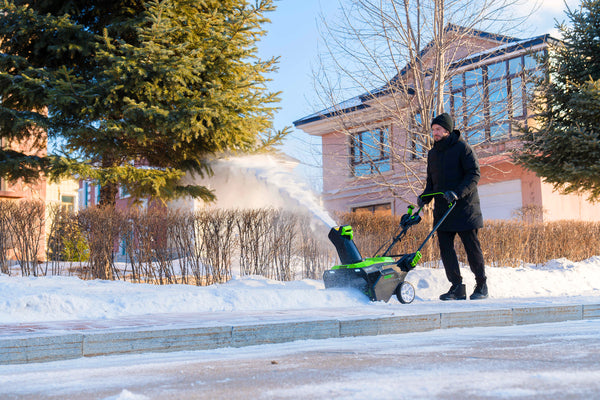When winter shows up with full force, your snow blower becomes a neighborhood hero. But what happens when your trusty machine won’t start, makes weird noises, or just isn’t throwing snow like it used to? Before you panic (or break your back shoveling) take a deep breath. Most snow blower issues are easy to fix with a few simple tools and the right snow blower parts!
In this Greenworks blog, we’ll walk you through the most common snow blower problems and how to fix them to get you back to clearing snow in no time.
You’ve Got Snow Blower Problems, We’ve Got Solutions!
1. My Snow Blower Won’t Start
THE FIX:
A non-starting snow blower is the most common cold-weather complaint. Start by checking the basics:
- Is there fresh fuel in the tank?
- Is the spark plug clean and connected?
- Is the choke set correctly?
If you’ve ruled those out, you may need to replace the spark plug or carburetor—both are affordable and easy to install. Snow blower repair parts are available online and at most hardware stores.

2. The Auger Isn’t Turning
The auger in your snow blower is the front spiral blade that does the heavy lifting—if it’s not spinning, then snow isn’t moving.
THE FIX:
Turn off the machine and inspect the shear pins. These small parts are designed to break if the auger hits a solid object (like a hidden rock), preventing damage to the gear case.

GREENWORKS TIP: Replacing broken shear pins is a quick DIY task. Just make sure you buy the correct snow blower replacement parts for your model by calling your manufacturer or checking the manual.
3. The Snow Isn’t Blowing Far Enough
THE FIX:
This could mean your impeller (the fan that throws snow through the chute) is jammed or worn down. You might also have a clogged chute—especially if the snow is wet and heavy. Unclog the chute with a clean-out tool or stick. Never use your hands! If the impeller looks worn, it’s time to shop for parts for snow blower performance (like a new impeller kit).

4. The Drive System is Slipping or Not Moving
THE FIX:
If your snow blower isn’t propelling forward as it should, you might be dealing with a worn-out drive belt or friction disc. These are both common snow blower parts that wear out over time, especially with heavy use. Open the bottom plate of the blower to inspect and replace any parts showing significant wear. While you’re in there, check for signs of oil or fuel leaks that could affect traction.

5. The Chute Won’t Turn or Tilt
THE FIX:
If the chute isn’t responding to the controls, it’s likely a problem with the cables, gears, or motor (for electric models). Inspect for fraying, corrosion, or broken connectors. You can usually fix this with small snow blower repair parts like a new gear assembly or chute cable.

Pro Tips to Stay Ahead of Snow Blower Repairs:
- Keep a small stash of essential snow blower replacement parts on hand so you’re never caught off guard (we recommend shear pins, belts, and spark plugs).
- After each use, brush off snow and ice buildup to prevent rust.
- Do a full inspection before the first snowstorm of the season—trust us, it’s better than troubleshooting on a freezing winter morning!
Final Thoughts on Snow Blower Parts
A Little Snow Blower TLC Goes a Long Way
A well-maintained snow blower can last many winters, so stock up on the necessary parts for snow blower upkeep and keep your winter wonder working like a champ!
Additional Snow Blower Resources from the Greenworks Blog
Not sure whether to buy an electric or gas snow blower? Learn the pros and cons of each when you read about Electric vs. Gas Snow Blowers.
What’s the difference between a Snow Blower vs. a Snow Thrower? Find out now!
























































